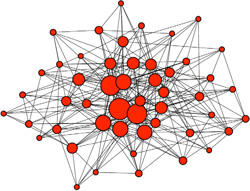Article
Creation and Evaluation of a Student-centered, Blended Learning Environment for Organic Chemistry
Michael Evans
Ph.D. student
Department of Chemistry. University of Illinois at Urbana-Champaign.

Faced with increased pressure due to larger class sizes and more substantial research demands, many modern chemical educators are turning to innovative pedagogical techniques to efficiently teach large numbers of undergraduates. For a second-semester organic chemistry course for non-chemistry majors, we have embraced a blended, student-centered approach. Course designs employing a combination of live and online content (blended courses) are ideally suited for student-centered instruction, as consumption of online materials is typically the responsibility of the student, and instructors can shift the focus of live class time away from pure content and toward helping students learn independently. Instead of planning passive lectures, we now develop problem-solving sessions and serve as coaches and mentors for students in live discussion sessions. We have also begun to explore student-centered course evaluation methods, which use student self-reports of learning gains and feedback to guide course development. Our ultimate goal is the development of a self-sustaining blended learning framework for organic chemical education that maximizes student learning.
Two-photon Fluorescence Microscopy by Shaping a Fiber Supercontinuum
Yuan Liu
Graduate Research Assistant
Department of Bioengineering, University of Illinois at Urbana-Champaign
Pulse shaping of a broadband laser pulse provides control over optical processes in biological samples and is emerging as a powerful technique in optical microscopy and spectroscopy. In this study, two-photon fluorescence microscopy is performed using ultrafast optical pulses shaped from a fiber supercontinuum spanning from 900 to 1150 nm. The supercontinuum is generated by coupling pulses from an ultrafast Yb:KYW laser into a nonlinear photonic crystal fiber. The supercontinuum is then amplitude and phase shaped by a spatial light modulator for two-photon fluorescence imaging. Second harmonic generation spectra of pulses under a microscope objective are used to evaluate the effects of shaping. Selective and efficient two-photon excitation of fluorophores is demonstrated in GFP fibroblasts with mitochondria co-labeled with Mitotracker Red, as well as mouse skin tissue. Shaping a fiber supercontinuum enables selective and efficient two-photon excitation over a broad bandwidth with a single-beam and an easily tunable setup, providing a novel method for performing two-photon fluorescence microscopy.
Nonlinear Dynamical Multi-Scale Model of Associative Memory
Alex Duda
Graduate student
Language Acquisition and Robotics Group

We discuss a new ab initio nonlinear dynamical multi-scale model that will serve as the foundation for an associative memory to be implemented within a humanoid robot - Bert, the iCub. Scale 0 consists of spiking Hodgkin- Huxley (HH) neurons. Scale 1 consists of components that are made up of large populations of HH neurons whose topological structure evolves according to a Hebbian-plasticity rule based on synchronous firing. The component's state is captured by the variance of phase synchrony for the population. Many such components are sparsely connected to form a large network, whose state can be captured by the n-tuple consisting of the individual states of each member component. Scale 2 takes the state of the overall network and upon examining the particular interrelationships of each component (determining how the state of one component affects the state of others) is able to generate a class of trajectories, which can serve as a basis for an associative memory. The details of the different scales are examined.
Beckman Institute for Advanced Science and Technology